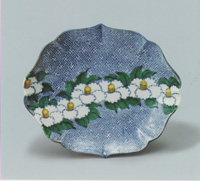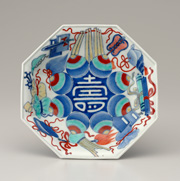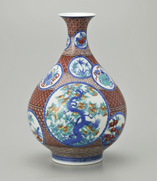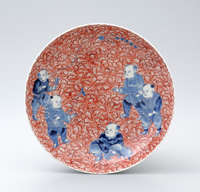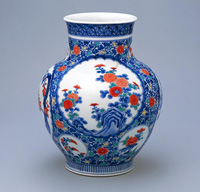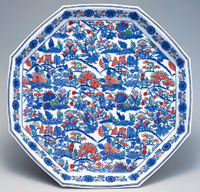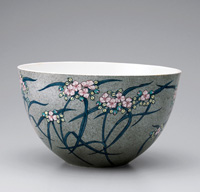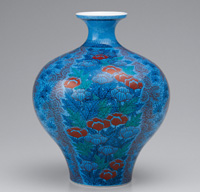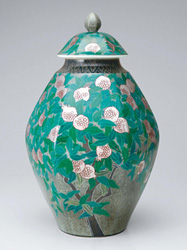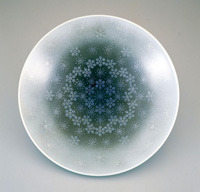Iro-Nabeshima (porcelain with multi-coloured overglazed enamel) by Imaemon is created based on techniques dating back to the Edo period (mid-17th century). These techniques have been preserved for about 370 years. Characterized by a distinctive gracefulness, the Imaemon colored porcelain is greatly appreciated till this day.
The superb techniques preserved at Imaemon Kiln have been designated as an Important Intangible Cultural Property of Japan.
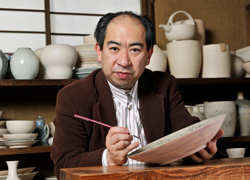
Imaizumi Imaemon XIV
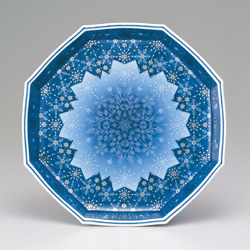
The mission of Imaemon is to pass the art of the shogun era down to posterity and make people's daily lives better and more enjoyable with our colored porcelain. These are our fundamental philosophies. Tradition does not just mean maintaining old techniques, tradition also means using old techniques to create new values for modern people.
Always maintaining these philosophies, Imaemon Kiln produces two styles of porcelain: works of Imaizumi Imaemon XIV, which pursue the grace of modern Imaemon, the second, works that preserve the traditional Iro-Nabeshima style of the Edo period.
Day after day, the creative work at Imaemon is continued in the hope that the art will help preserve genuine Japanese culture, which appreciates the four distinct seasons and people's links with heartwarming hospitality for each other and with objects.
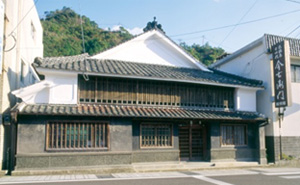 [Kiln and Showroom]
[Kiln and Showroom]
2-1-15, Akaemachi, Arita-cho, Nishimatsuura-gun,
Saga, 844-0006 JAPAN Googlemap ≫ Transport guide ≫
TEL +81-(0)955-42-3101
arita@imaemon.co.jp
Shop hours 8:00-17:00
Closed on the first Sunday
 [Shop in Tokyo]
[Shop in Tokyo]
2-6-5, Minamiaoyama, Minato-ku,
Tokyo, 107-0062, JAPAN Googlemap ≫ Transport guide ≫
TEL +81-(0)3-3401-3441
tokyo@imaemon.co.jp
Shop hours 9:00-18:00
Closed on Sunday and National holiday
Lord Nabeshima, feudal lord of Saga domain had a clan kiln and produced Nabeshima ware for tribute to the Tokugawa shogunate or for the usage within the Saga castle during the Edo period (1603-1868). It is highly appraised worldwide as a type of porcelain with multi-coloured overglazed paint that represents elaborate techniques, innovative design and elegance. These porcelains are currently known as Iro-Nabeshima, decorated overglaze in red, yellow and green on underglaze blue.
Lord Nabeshima designated the Imaemon family who had the most sophisticated techniques for the polychromatic overglazing process in Akae-machi, as the sole Akae-ya (polychrome overglaze specialist) for producing porcelains for the feudal lord by hereditary. The blending components and techniques were protected and were only inherited to one of his children.
Since the Meiji era, Imaemon family has engaged not only in applying the overglaze enamels but also in the whole production process from working with clay in 1871. Three generations of Imaemon ?X, XI and XII? managed to revive Iro-Nabeshima and brought it back its former glory. Subsequently Imaemon kiln was designated as an Important Intangible Cultural Property in 1971. Imaemon kiln complies with and maintains the whole process as it was carried out manually during the Edo period.
Furthermore, Imaemon XIII is credited with having added artistic dimensions to Iro-Nabeshima. He modernized Iro-Nabeshima by establishing techniques such as “fukizumi” (technique of spraying on the pigment for underglaze cobalt blue), “usuzumi” (technique of spraying on the pigment for underglaze colour of light grey), “fuki-gasane” (combination of fukizumi and usuzumi). Imaemon XIII was designated as a Living National Treasure.
And in 2002, his son, Masato, succeeded as Imaemon XIV. Inheriting traditional techniques of Iro-Nabeshima, Imaemon XIV also has been exploring exquisite characters of modern Iro-Nabeshima in his own way by using “sumi-hajiki” (traditional technique of the reverse pattern in white by using India ink’s feature of repelling pigment and disappearing after firing). He won special recognition for his art from the Japanese government (Shijyu hosho, Medal with Purple Ribbon) in 2009 and was designated as a Living National Treasure (an Important Intangible Cultural Property -overglaze enamel decorated porcelain) in 2014.

